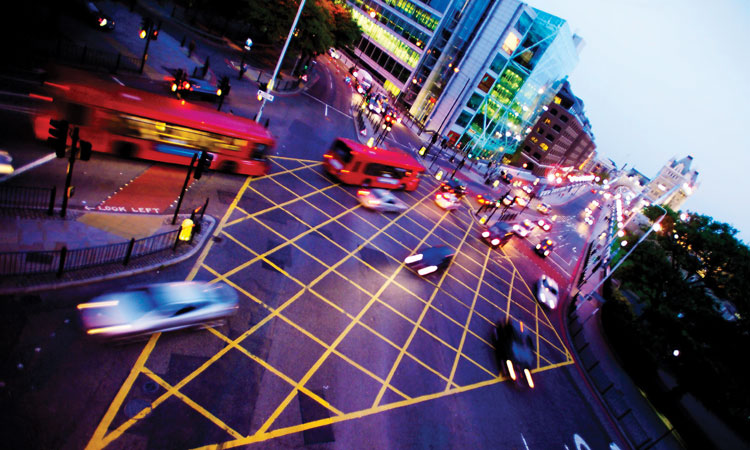Transport management systems: ITS is dead, long live ITS
- Like
- Digg
- Del
- Tumblr
- VKontakte
- Buffer
- Love This
- Odnoklassniki
- Meneame
- Blogger
- Amazon
- Yahoo Mail
- Gmail
- AOL
- Newsvine
- HackerNews
- Evernote
- MySpace
- Mail.ru
- Viadeo
- Line
- Comments
- Yummly
- SMS
- Viber
- Telegram
- Subscribe
- Skype
- Facebook Messenger
- Kakao
- LiveJournal
- Yammer
- Edgar
- Fintel
- Mix
- Instapaper
- Copy Link
Posted: 28 August 2016 | Jonathan Clough, Nathan Ashley | No comments yet
Transport for London’s Jonathan Clough, Intelligent Transport Systems Specialist (Road Space Management Outcomes Delivery Team) and Nathan Ashley, Policy Advisor (Corporate Strategy and Planning Team) explore London’s investment plans in Intelligent Transport Systems including implementing the world-leading Surface Intelligent Transport Systems (SITS) programme to expand access to real-time data.


Without Intelligent Transport Systems (ITS) London’s road network would grind to a halt. Our operational staff are using 6,300 traffic signals, approximately 1,000 CCTV cameras and more than 100 variable message signs (VMS) to monitor and influence traffic flows 24 hours a day, 365 days a year. These systems deliver huge benefits to road users – our adaptive signal control system, SCOOT, alone is responsible for reducing delays in traffic by up to 12 per cent.
The advancement of these technologies since ITS’ inception in the 1980s has allowed us to manage London’s huge growth. However, these systems have all had one thing in common; the vast array of infrastructure required at the roadside. From sensors to signals, the maintenance of this infrastructure can lead to colossal maintenance bills for transport authorities – this is not ideal at a time where funding is constantly under pressure. Should our past guide our investment in these technologies in the future?
Meanwhile, other industries have witnessed the disappearance of physical infrastructure and premises. The downfall of Blockbuster to be replaced by Netflix shows the devastating effect that ‘disruptive technologies’ can have on established business models and this Bricks vs Clicks debate is now taking hold in the transport sector. Why buy and maintain infrastructure if the same information and insight it provides can purchased as a service at a lower cost?
Data as a service
We are now starting to see the emergence of these business models in the transport sector. Mobility Service Providers, such as HERE and TomTom, are building commercial offerings that allow road authorities to take advantage of their data directly from satellite navigation devices and connected vehicles. This data can be used in real-time for network management to understand traffic flows and identify incidents, or for longer-term strategic planning by identifying trends in origin-destination flows around the city.
At Transport for London (TfL) we are looking to take advantage of this emerging area through our partnership in the TM2.0 project. This project consists of international stakeholders interested in developing a more efficient and integrated traffic management process; consisting of both the Mobility Service Providers and road authorities. By working with these consumer facing partners, road authorities can build relationships with drivers, providing information personalised to each individual.
We have seen the huge benefits that these personalised relationships bring for users of London’s public transport. The effective Travel Demand Management (TDM) necessary for events such as the London 2012 Olympic Games, or the 2014 Tour de France stage hosted in the Capital, wouldn’t have been possible without the personalised relationships that smartcard ticketing on Oyster and contactless cards allow us to build with our customers. It allowed us to build up a profile of customers who regularly use the same routes so that we could provide personalised information if it was closed or disrupted, helping the customer to plan an alternative journey and carry on with their day.
Providing similar information to drivers directly in their vehicles through their smartphone or satellite navigation device will be hugely important to the future management of London’s road network. It will give us the ability to help drivers change their behaviour in real-time and we know this information is valued by our road customers: a recent trial which saw journey times displayed on key routes using VMS signs was rated as useful by 78% of drivers who saw the signs.
Providing this information gives drivers the ability to choose alternative routes or travel at a different time. However, the real benefits of these technologies will come from taking a more holistic approach to the management of the transport network, by encouraging drivers to take public transport instead when the roads are busy, or to combine driving as part of a truly multi-modal journey. These benefits cannot be realised by technological advances alone, but require new business models and behaviour change programmes.
The end of the magnetic loop?
With Mobility Service Providers changing the way road authorities gather data for operational reasons and new business models changing the way people travel in cities, what does the future hold for the roadside technology and infrastructure that road authorities rely on for data gathering?
At the recent European ITS Conference in Glasgow a BeMobile representative stated that research they had undertaken with Siemens in the Netherlands had shown that by fusing Mobility Service Provider data with road authority loop data they could acquire the same accuracy of flow data with 90 per cent less loops.
This shows that there are cost savings to be realised by road authorities. However, the requirement to have a level of loop coverage shows that infrastructure is still required to ensure the quality of data received from Mobility Service Providers and other third parties meets the standard required for traffic management. This is particularly important as commercial sensitivities mean that Mobility Service Providers provide very little information about the data cleansing and analytics that takes place before they send the data to roads authorities. By fusing their own datasets with these new ones authorities can improve data quality and increase coverage of their monitoring systems, whilst considering scaling back on infrastructure.
This data fusion approach requires development of new approaches within authorities; the bringing together of traditional ITS specialists with specialists in data science and a variety of other fields. If this can be successfully achieved authorities can start to plan better, not only for their transport systems, but for cities as a whole.
From smart to future city
Using data and sensor technologies to provide insight is at the core of trying to be a ‘Smart City’. While our priority is to provide safe, world-class transport services to our customers, we also consider ourselves to be a huge data and information business.
Data is our new currency. To provide a reliable service, maximise capacity and keep customers engaged, we need to ensure our systems are integrated; providing both an historical and real-time view of what is going on and assess patterns and trends to support operational planning and influence customer behaviour. As such, we are continually exploring how we can leverage data to pre-empt and solve problems and ultimately make the right decisions for London.
To get value from data, it needs to be translated into useful information that can be applied to tools that can help plan and run services. City leaders and planning authorities have a huge opportunity to take the lead in creating and using policies, and invest in digital technology – both address the sorts of challenges facing developed cities all around the world, and London is no different.
London is growing. The population is set to reach 10 million by 2030, from its current record level of 8.6 million residents. Both population and economic growth has put strain on our transport network but, despite this, the Tube continues to break records for the number of customers carried. The vast majority of the busiest days in the Tube’s 152-year history were in 2015, with an all-time record of 4.821 million people on 4 December. There are more than 30 million journeys across our networks each day and we expect another five million trips a day by 2040.
ITS is here to stay
Intelligent Transport Systems are here to stay. The benefits of traditional technologies are proven, whilst new technologies have the ability to reduce cost and increase coverage. However, ITS is changing. Customers may not need to know whether the data being used to control traffic signals is coming from their vehicle or a sensor at the roadside, but ITS professionals are going to have to upgrade their skillsets and develop new systems to work with the opportunities presented by ‘Big Data’.
At TfL we have never stood still when it comes to technological improvements. London is the home of the world’s first underground railway. Our buses are leading the way in going green. We are top of the class on ticketing technology. Our open data already provides real customer benefits every day.
However, this city is only as smart as the infrastructure that ties it together. In order to get meaningful insights to transform the city the systems need to talk to one another. There are of course challenges. We need to be agile enough to respond to change as it happens, and to use that change for the long-term benefit of the Capital.
This is why we are delivering the Surface Intelligent Transport System (SITS) programme. It will revolutionise traffic management in the Capital, replacing our Urban Traffic Control (UTC) system with a world-class ITS system that allows us to fuse our existing data sources with those of third parties in real-time to improve road network management. The richness of these new data sources will enable new capabilities: the ability to predict future traffic demand using faster than real-time models will allow us to mitigate traffic congestion before it occurs; whilst new partnerships and open data sources will allow us to get information to our customers exactly when they need it in order to make more informed choices.
Both within and beyond the SITS programme our challenge now is to anticipate the new technologies and innovations that will change both how we conceive infrastructure in the future and how we will provide it. It is absolutely not the time to limit our ambition for this great city.
A Smart London, then, is one where we work with the industry, with the academics and researchers, with engineers and, crucially, with all our customers and users, to define and create the kind of London we want in the future. We must do that now. We must do that quickly. In this way, we will have created the conditions, the right framework and the right technology to create a better London for all.
Biography




Related topics
Fleet Management & Maintenance, Infrastructure & Urban Planning, Intelligent Transport Systems (ITS), Sustainable Urban Transport, Transport Governance & Policy
Issue
Issue 4 2016
Related organisations
Blockbuster, Netflix, Transport for London (TfL)








